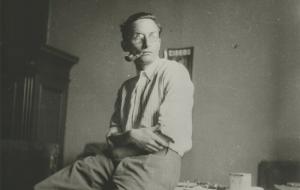John B. Watson: life and work of the behavioral psychologist
John B. Watson, next to Ivan Pavlov, he was one of the important characters of the classical conditioning and was key to the subsequent development of the Operant Conditioning made famous by B.F. Skinner. Both classical conditioning and operant or instrumental conditioning are part of the behaviorism, one of the most prominent currents in psychology.
Although classical conditioning was born thanks to the experiments of the Russian physiologist Ivan Pavlov, who became interested in salivation reflexes in dogs, Watson introduced him to the United States where he had a great impact on the American educational system.
Biography of John Broadus Watson
John Broadus Watson was born in Greenville (South Carolina, United States) in 1878 and died in New York in 1958.
He studied at the University of Chicago and graduated in 1903. He wrote many scientific articles, one of the first called "Animal Education: A Study experimental on the psychic development of a white rat, in correlation with the growth of its nervous system". In this article
he describes the relationship between brain myelination and learning ability in rodents.Watson worked at John Hopkins University for 14 years, and there he conducted a large number of experiments on the learning of birds. In 1920 he left his job at the University because of rumors about a romantic relationship with his assistant Rosalie Reyner, with whom he carried out his famous experiment with "little albert". Then He went on to work as a psychologist at the Thompson company, and became interested in the field of advertising.
One of the most influential psychologists of the s. XX
As Professor of Psychology at John Hopkins University (United States) between 1908 and 1920, Watson He was considered one of the most influential and decisive figures of the last century. His work is studied today in all faculties of psychology around the globe, and is one of the bases of learning and treatment of some psychopathologies such as phobias. Therefore, his conclusions cannot be lacking in any introductory book on psychology.
Although his career as an academic was short, his legacy has been hotly debated for nearly a century. Watson helped define the study of behavior and psychology as a science, and emphasized the importance of learning and the influence of context on the development of human beings.
Watson popularized behaviorism
He was a radical behaviorist, an anti-mentalist, and as such, criticized Sigmund Freud and psychoanalysis, since he affirmed that the study of conscience and introspection had no place in psychology as science. Psychology according to Watson, only made sense through observable and measurable behaviorTherefore, his experiments were carried out in the laboratory, where he could manipulate the environment and control the behavior of his subjects.
The objective of behaviorism is to make psychology a natural science, and therefore, it must have methods that allow observing, measuring and predicting variables. John B. Watson will always be remembered as the person who coined and popularized behaviorism thanks to his publications and his research.
Classical conditioning
Watson's contributions to behaviorism are due to his classical conditioning experiments, a type of learning that involves automatic or reflex responses, and that is characterized by the creation of a connection between a new stimulus and an existing reflex. That is to say, it is a type of learning according to which a neutral stimulus, which does not provoke a response, comes to be able to provoke it thanks to the associative connection of this stimulus with the stimulus that normally causes said answer.
John Watson was inspired by the research of the Russian psychologist Ivan Pavlov, but also he thought classical conditioning also explained learning in humans. Watson was clear that emotions were also learned through conditioned association, so the differences in behavior between humans were due to the different experiences that each He lived.
- If you want to know more about classical Conditioning and Ivan Pavlov's experiments, we invite you to read our article: “Classical conditioning and its most important experiments”
The experiment with "little Albert"
To test his hypothesis that emotions could be learned by conditioned association, Watson used an 11-month-old boy named Albert as an experimental subject. It should be mentioned that this study could not be carried out at present because it violates scientific ethics.
Albert was taken to the laboratory where he was presented with a white rat. When the little boy approached to touch her, Watson struck a metal bar with a hammer. As a result of the strong blow, the baby became upset and, as a result of fear, began to cry. Watson repeated this process half a dozen times, and observed that, After various trials, little Albert was frightened simply by the fact that he saw the white rat. Albert had learned that every time the rat appeared, the hammer would hit the metal table. That is, he anticipated the strong blow.
Here we leave you a video so you can visualize the experiment:
Now, when the EN (white rat) occurs several times together with the EI (hammer blow) that causes an IR (fear), the EN (white rat) becomes a Conditioned Stimulus (EC). Then, the presence of the EC (that is, the white rat) causes a Conditioned Response (RC). The Conditioned Response equals RI (feeling of fear).
Classical conditioning and phobias
East it is the most frequent mechanism of acquisition of phobias, a strong irrational fear that some people suffer as a result of associating negative experiences with the presence of something (flying in an airplane, spiders, clowns, among many others).

